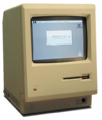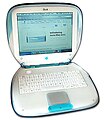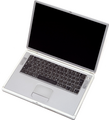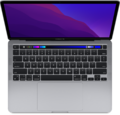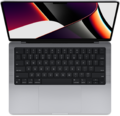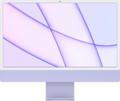The Mac is Apple's line of personal computers, originating with the 1984 "Compact" Macintosh 128K, and continuing today with the iMac, Mac mini, Mac Studio, Mac Pro, MacBook Pro, and MacBook Air.
History
Motorola 68k
Between 1984 and 1995, Apple released six major Macintosh product lines based on the Motorola 68k series of predominantly 32-bit processors. The Motorola 68k line of Macintoshes ran System 1.0 to Mac OS 8.1.
-
Macintosh 128K (1984), originator of the "compact" design
-
Macintosh II (1987), the first to support color graphics, and first in a "tower" design
-
Macintosh Portable (1989), the first battery-powered Macintosh
-
Macintosh Color Classic (1994), a later, redesigned "compact" Macintosh
-
Macintosh Performa 580CD/LC 580, along with Performa 640CD (1995), were the final Motorola 68k-based Macs
PowerPC
Between 1994 and 2006, Apple released six major product lines based on the PowerPC series of 32-bit processors, with 64-bit support in the PowerPC G5. The PowerPC era saw Apple's earliest involvement in processor design through the formation of the Apple-IBM-Motorola (AIM) alliance (simultaneous with their early involvement in ARM Holdings), in addition to the transition from classic Mac OS to Mac OS X. The PowerPC line of Macintoshes ran System 7.1.2 to Mac OS X Leopard.
The PowerPC line initially featured the Power Mac and PowerBook product lines. Following the 1997 return of Steve Jobs as CEO, the lineup was extended to include the iMac (and its education variant, eMac), Mac mini, and iBook.
-
PowerBook 100 (1991), Apple's first follow-up to the 1989 Macintosh Portable
-
iMac (1998) in "Bondi Blue", iconic for its departure from the design of previous Macs
-
iBook (1999) in "Blueberry" brought the iMac G3 design to Apple's portable line
-
Power Mac G4 Cube (2000), an early experiment in miniaturising the Mac hardware
-
PowerBook G4 Titanium (2001), an early example of Apple's shift in industrial design
-
iMac G4 (2002), the first affordable Mac desktop to use a flat-panel LCD
-
Xserve G4 (2002), a Mac product line in a rack-mounted form factor
-
Power Mac G5 (2003), the final PowerPC product release, alongside the iMac G5
Intel
Following Apple and IBM's failure to deliver the full planned PowerPC G5 product line, Apple's product line shifted to Intel x86 processors. The Intel Mac lineup began with the 2005 Developer Transition Kit hardware, featuring a Pentium 4 Prescott processor and Intel-designed motherboard in a PowerMac G5 case, releasing to retail in 2006, and continuing until 2020. While the Intel Mac product line was initially a regression from 64-bit PowerPC G5 to 32-bit Intel Core (Yonah), it was quickly transitioned to the 64-bit Intel Core 2 (Merom). The Intel line of Macs were first supported in Mac OS X Tiger 10.4.4 (with internal work dating back to System 7.1.2), and continue to be supported in current versions of macOS.
The Intel Mac architecture's strong similarity to traditional Intel x86-based PCs allowed for the introduction of Boot Camp, enabling a Mac to be dual-booted with versions of Windows between Windows XP and Windows 10.
The iMac, Mac mini, and Xserve product lines were continued, while the Power Mac, PowerBook, and iBook lines were replaced with the Mac Pro, MacBook Pro, and MacBook respectively, later also introducing the MacBook Air. The MacBook product line saw its final release in 2010, before briefly returning from 2015 to 2017 as a 12-inch ultra-portable notebook. The Xserve product line saw its final release in 2009.
Starting with the MacBook Pro (2016), some hardware responsibilities typically handled by the Intel Platform Controller Hub began to be replaced with the iBridge, an Apple-designed coprocessor running bridgeOS. iBridge replaces the System Management Controller, and is also responsible for the Touch Bar, Touch ID, and later, Secure Boot.
-
MacBook Air (2008), an ultra-portable notebook form factor
-
The aluminium iMac design was introduced in 2008, and continued with various revisions until 2020
-
MacBook Pro (2008) introduced the unibody design language, and was available in 13, 15, and 17-inch form factors
-
Mac mini (Early 2009), an example of the earlier Mac mini design
-
While Mac Pro from 2006 to 2012 reused the Power Mac G5 design, the Mac Pro (2013) used a unique "cylinder" design
-
The 2016 MacBook Pro redesign brought Touch ID and the new Touch Bar to the Mac platform
-
Mac mini (2018), the final Intel model in this product line
-
Mac Pro (2019) reverted to a tower design approach, following criticism of the 2013 design
Apple Silicon
With the advancements Apple had been achieving with the A-series systems-on-a-chip found in iPhone and iPad devices, and with growing concerns over delays in Intel's product roadmap, Apple saw fit to begin migrating the Mac platform to their in-house architecture, based on ARMv8.3. As with the Intel transition, Apple began by releasing the 2020 Developer Transition Kit hardware, featuring an A12Z-based system in a Mac mini case, proceeding to release Apple Silicon Macs to retail by late 2020.
The Apple Silicon lineup continues the iMac, Mac mini, MacBook Pro and MacBook Air product lines, while introducing the Mac Studio product line. A Mac Pro was released in June 2022, completing the transition.
So far, Apple Silicon chips have used a straightforward naming scheme:
- Base model, with no suffix, providing a balance of power and power efficiency
- Pro, focused on increasing CPU and GPU cores
- Max, further increasing GPU cores
- Ultra, a chiplet design featuring two Max chips
-
The MacBook Pro line was continued with the 13-inch with base chips, in addition to 14-inch (pictured) and 16-inch with Pro and Max chips.
-
A redesigned iMac was released in 2021 with Apple Silicon chips, bringing the slimmest form factor seen in a desktop Mac.
-
Mac Studio (2022), a new product line providing high-end performance in a form factor only somewhat larger than the Mac mini.
